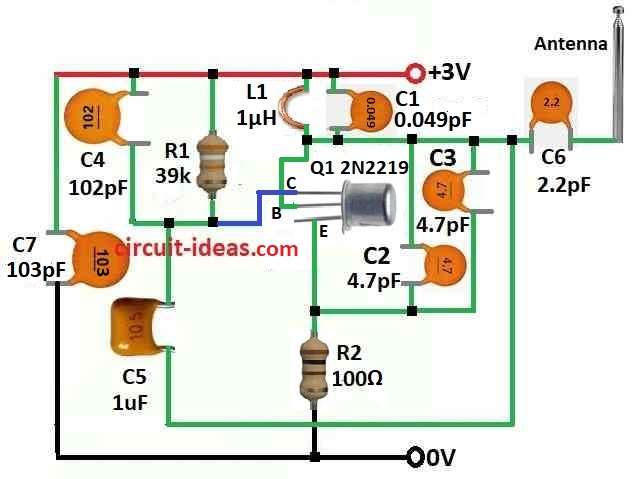Simple Mobile Phone Signal Jammer Circuit is device that stop signal between phone and tower.
It does this by using same radio frequency like phone and to make communication not to work.
This small circuit can block call and message on 3G, 4G and also old network.
Three main part inside jammer:
First is the amplifier which make signal more strong.
Second one is special circuit which creates right type radio waves.
Then the device change these waves so it can mix with phone signal.
When all part work together phone signal get jammed.
WARNING: In many countries jammers are illegal to use, sell, or make.
Using jammer can cause fine or jail in some places.
Emergency services like ambulance or police need clear signal and this jammer circuit can stop them.
Only government like military or police sometimes are allowed to use them.
Circuit working:

Parts List:
| Component | Quantity |
|---|---|
| Resistors (All resistors are 1/4 watt) | |
| 39k | 1 |
| 100Ω | 1 |
| Capacitors | |
| Ceramic 0.049pF | 1 |
| Ceramic 102pF | 1 |
| Ceramic 1uF | 1 |
| Ceramic 2.2pF | 1 |
| Ceramic 103pF | 1 |
| Ceramic 4.7pF | 2 |
| Semiconductors | |
| Transistor 2N2219 | 1 |
| Inductor 1uH | 1 |
| Antenna | 1 |
RF amplifier circuit have transistor Q1, capacitors C4, C5 and resistor R1.
This circuit make signal from tuned circuit more strong and then signal goes to antenna by capacitor C6 and this C6 stop DC but let AC go.
When transistor Q1 turns ON, tuned circuit at collector also start working.
Tuned circuit have capacitor C1 and inductor L1 which works like oscillator with very small resistance to make very high frequency.
This happen because capacitor charges and discharges again and again. It make oscillation but after some time small resistance come and stop oscillation.
Before C6 boost and mix frequency from tuned circuit with noise from capacitors C2 and C3 then RF amplifier power goes to collector through capacitor C5.
This give one combined signal which is strong and get transmitted.
Mobile phones use different frequency bands in world.
To make jammer circuit we have used one formula to find correct values.
Value of inductor L1 and capacitor C1 can change depending which frequency we want to block.
Example if phone in area use 450 MHz then jammer also make 450 MHz with noise. This confuses the phone and it cannot catch right signal.
Note : This circuit only work around 100 meter distance.
Important: Also using this circuit is illegal in most countries.
This information is only for learning not for any misuse.
Formula:
Resonant frequency (F) of simple LC circuit we find by this formula:
F = 1 / (2 × π × √(L1 × C1))
where:
- F is frequency in hertz Hz which shows max oscillation of circuit.
- π (pi) is math value which is about 3.14159.
- L1 is inductor value in Henrys H where inductor stops fast to change in current and store energy in magnetic field.
- C1 is capacitor value in farads F where capacitor store electric energy in electrostatic field.
About the Formula:
This formula connect inductance L1 and capacitance C1 to find frequency.
In LC circuit when inductor and capacitor gives same opposite reactance it make resonance.
This means inductors reactance XL and capacitors reactance XC cancel each other.
Square Root Part (√(L1 × C1)):
This show how much inductor and capacitor affect circuit together.
At resonance this effect becomes zero.
2π Factor:
2π is used to change reactance into frequency.
In AC circuits this is how frequency and reactance are connected.
In simple words:
This formula tell what frequency LC circuit will resonate.
It happen when inductor and capacitor balance each others effect.
Conclusion:
Simple Mobile Phone Signal Jammer Circuit is not allowed in many countries because they can stop important communication and emergency calls.
They also make trouble for other people using phone in legal way nearby.
Making jammer at home is also not legal, even for fun or learning.
So it is very important to build or use this kind of device as it against the law.
Phuff… where is to start.
1. With L1 (22mH) and C1 (15pF), oscillant strikes 277 kHz – nowhere to count mobile phone channel.
2. BF494 transister has max-out frequently of 120 MHz – nochance of making mobile phone channel.
3. R2 (100K) mean current of 0.01 mW for power-out no more than 30 nW in highlight. Insufficience for any jambling pweor.
4. C7 and C5 value should swamp otherwise killing of oscailliert.
Whole circuit will never fire any chance of work.
thank you for your suggestion, I have updated the changes accordingly.